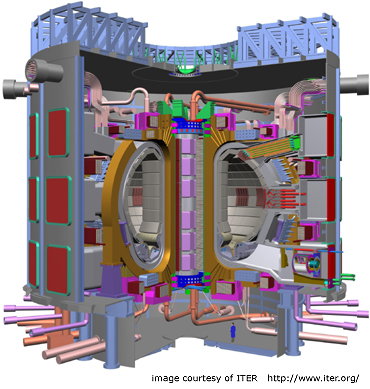Home >> Nuclear, nuclear fusion
fusion energy |
Energy from Fusion
Nuclear fusion: two (or more) atomic nuclei form a single heavier nucleus. The reaction only takes place at very high densities and temperatures.
There are many examples of fusion reactions. This is one of the more common ones - the fusion of deuterium with tritium to make helium(plus a neutron). Termed the D-T reaction.
![]()
The fusion reaction of two (or more) nuclei with masses lower than iron is exothermic (heat given out).
Conversely, the fusion reaction of two (or more) nuclei with masses greater than iron is endothermic (heat absorbed).
The source of the energy emitted is from the 'lost mass' when individual nucleons fuse together to make a nucleus. Matter is hence converted to energy according to Einstein's mass-energy equation E=mc2.
Of all the elements, iron has nuclei with the highest binding energy per nucleon.
So progressively, nuclei heavier than hydrogen are fused together. This increases the mass of resultant nuclei and the binding energy per nucleon up to the maximum at iron.
Calculation of energy released in the D-T reaction(above)
The method is to sum the mass of the products and subtract this from the mass of the reactants. This mass defect is then converted to energy units(MeV).
u = unified atomic mass unit (1/12 mass of a C-12 nucleus)
= 1.660539×10-27 kg = 931.494 MeV
mass of D = 2.014102 u mass of T = 3.016049 u
mass of He-4 = 4.002602 u mass of neutron = 1.008665 u
mass defect = mass of reactants - mass of products
= (2.014102)u + (3.016049)u - (4.002602)u - (1.008665)u
= 0.018884 u
since 1 u = 931.494 MeV,
mass defect = (0.018884) x (931.494) = 17.5903 MeV
Stellar Reactions
Hans Bethe(1939) was the first to suggest that fusion reactions involving hydrogen and helium were responsible for fusion in stars(the proton-proton cycle ). This is the reaction that is common in 'low temperature' stars, like our sun, which is one of the 'Main Sequence' group.
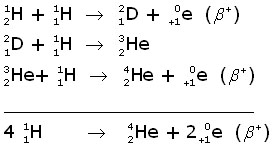
The energy release is approximately 27 MeV per cycle.
Another cycle, called the carbon-nitrogen cycle is thought to be prevalent in larger 'Main Sequence' stars. The cycle produces exactly the same result as the proton-proton reaction, but involves nitrogen and carbon in the reaction.
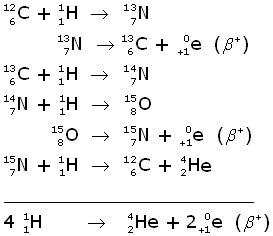
Plasma
First observed in a discharge tube(Crooke's Tube) around 1879, plasma is accepted as being a neutral 'gas' composed of electrons and ions. The plasma state for fusion to occur is at around 108 K.
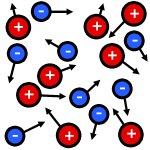
So the problem of studying plasma is one of containment, since all materials would vaporize on exposure to the high temperatures. The answer is to use a 'magnetic bottle'. Essentially, the plasma is contained within a magnetic field.
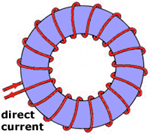
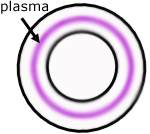
Because the particles are charged they corkscrew around the magnetic field lines. The most effective shape is a doughnut or toroid. This produces a powerful magnetic field within it, much like a linear electromagnet, but closed into a loop.
Controlled Fusion
A tokamak (Russian acronym) is a toroidal reactor.
To be fair, fusion is not at present a viable source of energy. However, there is much international collaboration to make fusion-power a reality. The International Thermonuclear Experimental Reactor project is central to this aspiration.
When it is complete, the ITER Tokamak will be the largest fusion reactor ever built. It will be approximately 30 m tall, weigh 23 000 tonnes and have a plasma volume of 840 m3. This scale is almost a factor of ten over previous reactors.
When ITER comes on-stream in 2018, it hopes to achieve 500 MW of output power for 50 MW input. This amounts to a power output/input ratio of 10.
The H-bomb
Believe it or not, the H-bomb does NOT get most of its energy from nuclear fusion. Most of the energy released in a thermonuclear explosion comes from the fission reaction.
True, a fusion reaction does take place, but this is just to make the fission reaction more efficient. This happens by the fusion reactions providing a greater neutron density. So a greater number of fission reactions can take place.
The H-bomb owes its design to Edward Teller and Stanislaw Ulam.
Essentially, one fission bomb sets off another with fusion material(lithium deuteride) sandwiched within it. Compression and a supply of neutrons from the first bomb initiates fusion. The massive numbers of neutrons produced trigger the second fission reaction.
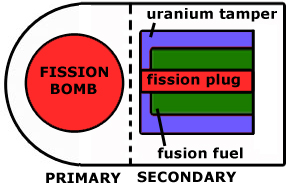
Neutrons are created by fission from the primary explosion:
![]()
Under intense heat lithium deuteride(LiD) dissociates into lithium and deuterium ions:
![]()
More neutrons go on to react with the lithium to provide tritium.
![]()
The deuterium and the tritium react, producing helium and a supply of neutrons.
![]()
Remember it is these neutrons that go on to initiate the second(and more powerful) fission reaction.
[ About ] [ FAQ ] [ Links ] [ Terms & Conditions ] [ Privacy ] [ Site Map ] [ Contact ]

